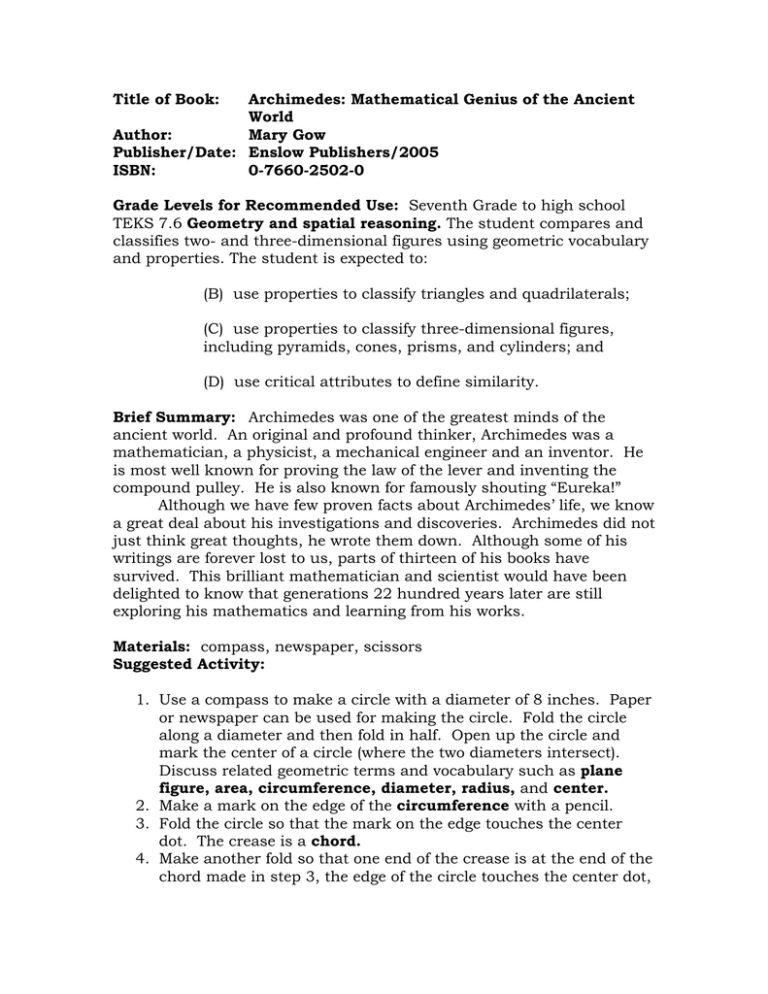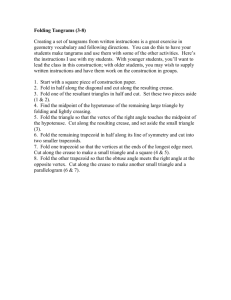Geometric vocabulary
advertisement

Title of Book: Archimedes: Mathematical Genius of the Ancient World Author: Mary Gow Publisher/Date: Enslow Publishers/2005 ISBN: 0-7660-2502-0 Grade Levels for Recommended Use: Seventh Grade to high school TEKS 7.6 Geometry and spatial reasoning. The student compares and classifies two- and three-dimensional figures using geometric vocabulary and properties. The student is expected to: (B) use properties to classify triangles and quadrilaterals; (C) use properties to classify three-dimensional figures, including pyramids, cones, prisms, and cylinders; and (D) use critical attributes to define similarity. Brief Summary: Archimedes was one of the greatest minds of the ancient world. An original and profound thinker, Archimedes was a mathematician, a physicist, a mechanical engineer and an inventor. He is most well known for proving the law of the lever and inventing the compound pulley. He is also known for famously shouting “Eureka!” Although we have few proven facts about Archimedes’ life, we know a great deal about his investigations and discoveries. Archimedes did not just think great thoughts, he wrote them down. Although some of his writings are forever lost to us, parts of thirteen of his books have survived. This brilliant mathematician and scientist would have been delighted to know that generations 22 hundred years later are still exploring his mathematics and learning from his works. Materials: compass, newspaper, scissors Suggested Activity: 1. Use a compass to make a circle with a diameter of 8 inches. Paper or newspaper can be used for making the circle. Fold the circle along a diameter and then fold in half. Open up the circle and mark the center of a circle (where the two diameters intersect). Discuss related geometric terms and vocabulary such as plane figure, area, circumference, diameter, radius, and center. 2. Make a mark on the edge of the circumference with a pencil. 3. Fold the circle so that the mark on the edge touches the center dot. The crease is a chord. 4. Make another fold so that one end of the crease is at the end of the chord made in step 3, the edge of the circle touches the center dot, and the segment is congruent to the smaller segment made in step 3. The folded figure now looks like an ice cream cone. 5. Make a third fold so that the edge of the circle touches the center dot and the ends of the crease touch one endpoint of each of the other chords. The figure formed is an equilateral triangle. Discuss area, perimeter, sides, and angles. 6. Find the midpoint of one side of the triangle by folding that side in half. Unfold it. 7. Fold the midpoint to the opposite vertex. Discuss trapezoid, isosceles trapezoid, polygon, parallel and intersecting lines, acute, and obtuse angles. 8. The trapezoid is divided into three equilateral triangles. Fold one of the equilateral triangles over the center triangle. Discuss rhombus, parallelogram and quadrilateral. 9. Fold the last triangle over the other two. Point out that the smaller triangles are congruent and they are similar to the larger triangle. 10.Set the folded triangles in the palm of your hand. With a little nudging, it will open to form a pyramid. Discuss base, vertex, edge, face, and volume. This pyramid has a triangle for a base and is therefore called a triangular pyramid. Another name for it is tetrahedron. 11.Open the figure to the original large triangle. 12.Fold each vertex to the center dot and crease. Discuss hexagon and regular polygons. 13.Gently let the sides rise; coax the figure to become a truncated pyramid. How many faces are there for this shape? What shapes are the faces? 14.Open to the large triangle. Fold one small triangle over the center triangle and then fold back a triangle whose side is about twothirds the side of a small triangle. You have made an accordion pleat. Fold each of the two small triangles the same way. Your now have a six-pointed star. 15.Refold along existing fold lines to create different convex polygons. Record your results on isometric dot paper or triangle grid paper. (There are 10 possible convex polygons.) 16.By making back-fold as you did for the six-pointed star, you can make concave polygons. Make as many concave polygons as possible and record your results. (There are 10 possible concave polygons.) You have completed a hands-on visual lesson in geometry and held two-and three-dimensional shapes in the palm of your hand! Sobel, Max A. and Evan M. Malestsky. Teaching Mathematics: A Sourcebook of Aids, Activities, and Strategies. Boston: Allyn and Bacon, 1999, pp. 181-183. Adapted by Dr. Faye Bruun, 2012



